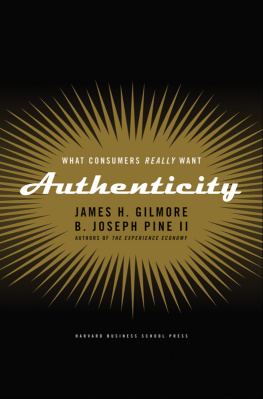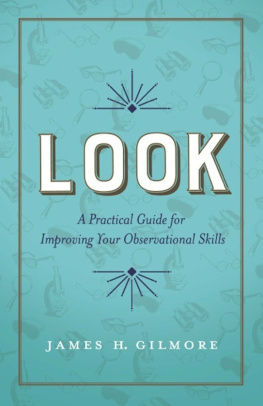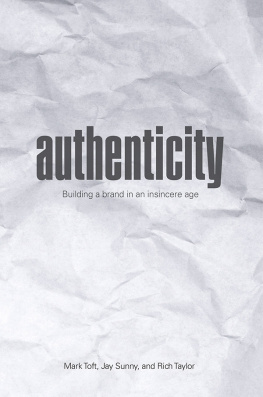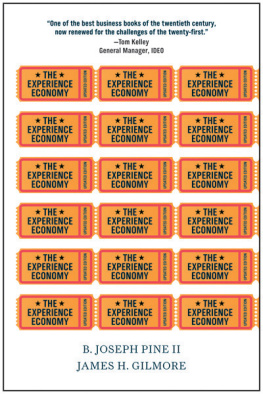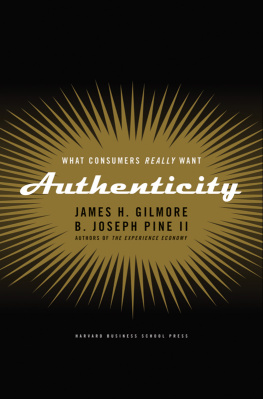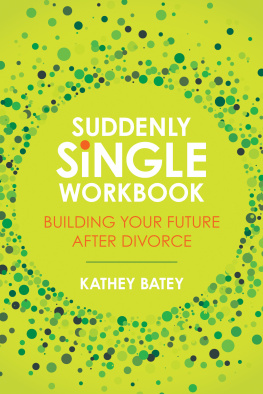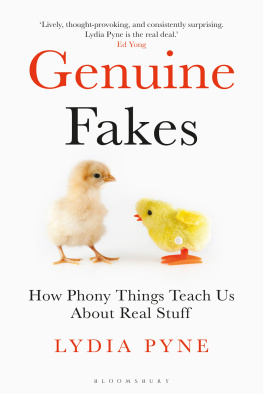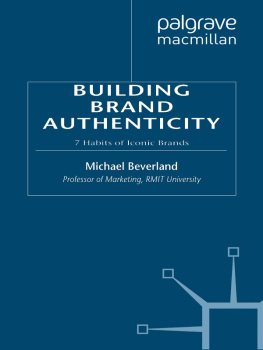Authenticity
Also by the Authors
The Experience Economy:
Work Is Theatre & Every Business a Stage
Mass Customization:
The New Frontier in Business Competition

JAMES H. GILMORE
B. JOSEPH PINE II
HARVARD BUSINESS SCHOOL PRESS
Boston, Massachusetts
Copyright 2007 James H. Gilmore and B. Joseph Pine II
All rights reserved
No part of this publication may be reproduced, stored in or introduced into a retrieval system, or transmitted, in any form, or by any means (electronic, mechanical, photocopying, recording, or otherwise), without the prior permission of the publisher. Requests for permission should be directed to permissions@hbsp.harvard.edu, or mailed to Permissions,Harvard Business School Publishing, 60 Harvard Way, Boston,Massachusetts 02163.
Library of Congress Cataloging-in-Publication Data
Gilmore, James H., 1959
Authenticity : contending with the new consumer sensibility / James H. Gilmore, B.
Joseph Pine II.
p. cm.
ISBN-13: 978-1-59139-145-6 (hardcover : alk. paper)
ISBN-10: 1-59139-145-8
1. Product management. 2. Consumer behavior. 3. Consumers preferences. I. Pine, B. Joseph. II. Title.
HF5415.15.G55 2007
658.8'343dc22
200701728
To those who
seek the realand
find the truth.
CONTENTS
The Appeal of Real
Drivers of the New Consumer Sensibility
Reality, Fakery, and Three Axioms of Authenticity
Five Genres of Authenticity
Lessons from Philosophy
Two Time-Honored Standards of Authenticity
Ten Elements of Authenticity
The Placemaking Portfolio
Here-and-Now Space
Real/Fake Polarities
Authenticity will be the buzzword of the twenty-first century. And what is authentic? Anything that is not devised and structured to make a profit. Anything that is not controlled by corporations. Anything that exists for its own sake, that assumes its own shape. The modern world is the corporate equivalent of a formal garden, where everything is planted and arranged for effect. Where nothing is untouched, where nothing is authentic.
Robert Doniger, in Michael Crichtons Timeline
PREFACE
Raise the subject of authenticity today and many people eagerly talk about what is real and what is fake. The topicwhether concerning people, places, or thingstriggers strong opinions and passionate disagreements even among close friends. What we deem real may not seem so real to you; you may even view it as downright fake. Yet underlying any difference of opinion about what constitutes authenticity is a shared belief that whatever is real is valued. On that we all agree.
In business today, executives recognize that their leadership skills hinge largely on their ability to gain a reputation among employees as real. Middle managers grow frustrated when corporate culture mandates collective acts of fakery. Youve seen it: all heads nodding in agreement at the conclusion of a meeting, everyone dismissing the decision the moment they leave the conference room. Frontline workers feign certain desired behaviors, projecting a faked niceness that reflects poorly on the whole business. And when customers encounter real behavior, its so often really bad.
This book does not focus on such matters of executive leadership, organizational culture, or employee empowerment, as important as they may be. Rather, our concern lies in helping you manage the perceptions of real or fake held by the consumers of your enterprises outputbecause people increasingly make purchase decisions based on how real or fake they perceive various offerings. These perceptions flow directly from how well any particular offering conforms to the individual customers self-image.
As such, any offering we cite as exemplifying authenticity automatically runs the risk of alienating readers who do not deem it real themselves (because their self-image necessarily varies from ours). We know this firsthand, for the two of us have disagreed over particular examples in writing this book. We learned that it takes concerted effort not to let ones own personal views intrude when making a professional assessment of authenticity in businessand so we urge you not to miss the core of our analysis of how offerings appeal to authenticity with others because certain exemplars do not work for you.
In our last book, The Experience Economy, we introduced a whole new vocabulary for what was already underway in business. Here, in Authenticity, we must contend with a word full of import and meaning, one that has already gained considerable currency in business circles. We sort through the verbal commotion, clarify the issues, and encourage business practices that as of yet few do. In essence, we strive to introduce a whole new management discipline. Think here of how Demings thought served to elevate quality as a distinct management responsibility. In this regard, authenticity is the new quality.
Particularly in the field of philosophy, but also in the arts, the social sciences, various strains of cultural criticism, and more recently in business, much has already been expounded on this subject. We have sifted through this body of thought to articulate our own philosophy of authenticity in business, found in and serving as a fulcrum for the book. To make a clear statement of what authenticity is, and what it is not, we necessarily include this material; to omit it would leave our work hollow and leave readers to wonder just where we stand on fundamental mattersas well as leave you without a touchstone to guide your own thinking on this issue.
Our method, as when we previously addressed the concepts of Mass Customization and the Experience Economy, lies in observing what is happening in the world of business, identifying far-reaching changes that threaten accepted ways of thinking, and then developing new frameworks to help executives, managers, and workers see the world differently and thereby figure out what to do about it. We view the subjects of Mass Customization, the Experience Economy, and now Authenticity in business as not only interlinked but as flowing one into another to form a single, cohesive view of the economic landscape. We make reference throughout this book to our prior work in these fields, not to forcibly recast everything in terms of authenticity, but as a practical demonstration of the long-term structural changes taking place in advanced economies and the interplay between major forces not only affecting the world of business but influencing the world at large. If weve done our job, as we did in The Experience Economy and Mass Customization before it, this book will have legs and well not have to write another such tome for a number of years.
Despite the success of our previous books, not enough businesses have shifted to mass customizing their offerings or staging experiences. In particular, too many have latched onto that single wordexperiencewithout changing core business practices. Too many companies say theyre offering experiences without actually staging experiences. That alone contributes greatly to being perceived as fake, and drives demand for experiences people deem authentic. Now more than ever, the authentic is what consumers really want.
This book examines the authenticity of economic offerings, not the authenticity of individuals in personal relationships, something people also greatly desire but the subject of many other tomes. We do recognize that many individuals reject the label consumer in any context. However, we take here the viewpoint of businesses, whose customersindividuals or other businessesconsume their economic offerings, and so the term is appropriate in this context.
Next page
